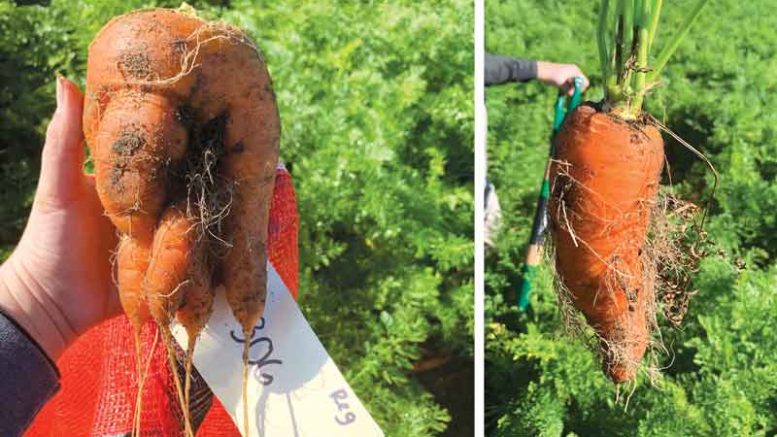Exploring Alternative Strategies for Nematode Management in Processing Carrots
By Elisabeth Darling, Sita Thapa and Marisol Quintanilla, Michigan State University
Plant-parasitic nematodes (PPN) alone can cause approximately $80 billion of annual crop loss worldwide. Root lesion nematodes (Pratylenchus spp.) are considered to be the third most economically important PPN in relation to their impact on crops, behind cyst nematodes and root-knot nematodes.
Historically, carrot growers have associated severe PPN damage with the root-knot nematode (Meloidogyne spp.) and, in some cases, the carrot cyst nematode (Heterodera carotae). However, more recently, the root lesion nematode (RLN) has become more prevalent in carrot fields, especially in mineral soils in Michigan.
The economic threshold for RLN is 50-100 nematodes per 100cc of soil. At these levels, RLN can result in the production of unmarketable characteristics such as stubby and forked carrots (Fig. 1).
Currently, the grower standard for PPN control in carrots is Vydate (oxamyl), which has shown reliable suppression of RLN. In 2016, Vydate became unavailable for the growing season, leaving many growers without reliable control for PPN. This incident emphasized the need for a reliable alternative to Vydate for nematode suppression.
In response, a flood of biologically based nematicides have become available to growers. However, the effectiveness of many of these new products has not been sufficiently evaluated. This highlights the necessity of evaluating alternative methods of control, specifically focusing on biological nematicides, incorporating compost and cover cropping using non-host plants.
Field Trial Results
For the past three years (2017, 2018 and 2019), the applied nematology laboratory at Michigan State University evaluated a list of chemical and biological compounds (Table 1) to manage nematodes in carrot plantings located in Hart, Michigan. In 2017, Vydate increased marketable yield in carrots. In 2018, carrot yields across all treatments (~40 tons/acre) were significantly higher than 2017 (~15 tons/acre). MeloCon was the only treatment that had a lower number of RLN than the control at 21 days post-application. In 2019, nematode pressure was considerably lower than in the past two years (>15 nematodes per 100cc). No trends existed across all three years. However, all treatments reduced nematode counts compared to the untreated control. The Layer Ash Blend (LAB) treatment produced the highest total yield in 2019, followed by a combination treatment of LAB and Vydate.
In addition to nematicide trials, our lab is beginning to evaluate non-host cover crops to reduce RLN. Thus far, we have evaluated multiple cover crops in growth chamber assays. Results indicate that the oilseed radish cultivars “Control,” “Concorde” and “Select,” as well as Dwarf Essex Rape are poor hosts of RLN. All the poor host cover crop cultivars from the growth chamber screening will be evaluated in carrot fields for nematode management in summer 2020.

Chemicals for Nematode Management
Over the past three growing seasons, we aimed to determine the efficacies of popular alternatives to Vydate. In the field trial established throughout the growing seasons of 2017, 2018 and 2019 in Hart, Michigan, plots were arranged in a complete randomized block pattern, and each treatment was replicated five times. Chemical or biological treatments (Table 1) were applied in the following ways: pre-plant (compost), in-furrow (Velum Prime, MeloCon, Majestene) and hand-held sprayer prior to plant (Nimitz). Soil samples were collected four times throughout the season: initial, 21-day post-application, mid-season and harvest. Soil samples were processed to identify nematode populations and diversity. A 1-meter row of carrots was selected within each plot to harvest and evaluate. Carrots harvested went through grading based on USDA standards, and each carrot was evaluated for nematode damage.
Despite seeing some trends between years, no treatment showed to have a significant reduction of unmarketable characteristics or yield comparable to Vydate. The turbulent 2019 field season proved to show considerable challenges for farmers and researchers. Although it is notable to mention that while not significantly, all treatments did outperform the untreated control plots in nematode reduction. For this reason, we are evaluating a new selection of biological nematicides, as well as performing preliminary evaluations on potential cover crops.

Cover Crops as Sustainable Strategy
As a non-chemical alternative, cover crops including oilseed radish (OSR) have been shown to reduce plant-parasitic nematode populations. Several studies have shown that OSR cover crops not only reduce nematode populations but also suppress weeds, recycle nitrogen and significantly improve carrot yields. Carrot growers feel OSR is an ideal cover crop because it winter kills, leaves behind less residue than other cover crops and provides a nice, “mellow” seedbed for the small-seeded carrots.
To qualify as a good cover crop for the management of plant-parasitic nematodes, the crop should be a poor host for the nematodes, thereby lowering the population after incorporation of the crop into the soil. Our main objective with this project is to identify excellent cover crop cultivars for the management of nematodes.
In growth chamber trials, we evaluated the host status of 10 OSR cultivars, tillage radish and Dwarf Essex Rape for the RLN. We found that OSR cultivars “Control,” “Concorde” and “Select” and Dwarf Essex Rape (Fig. 2) are poor hosts of RLN.
Currently, another trial for root-knot nematode is ongoing. This project is in the starting phase; however, results indicating poor hosts of both lesion nematode and root-knot nematode will be evaluated in carrot fields in summer 2020.

